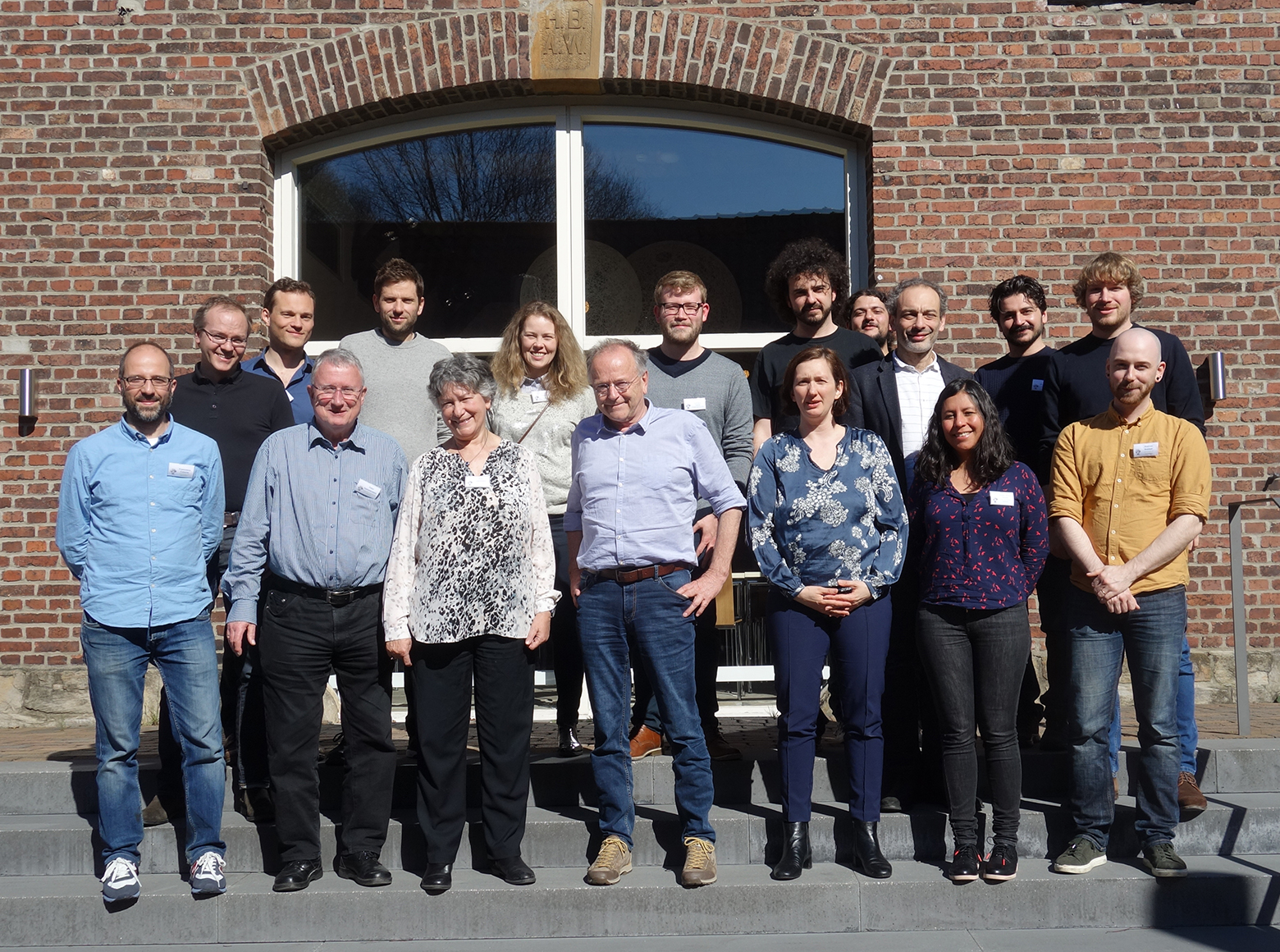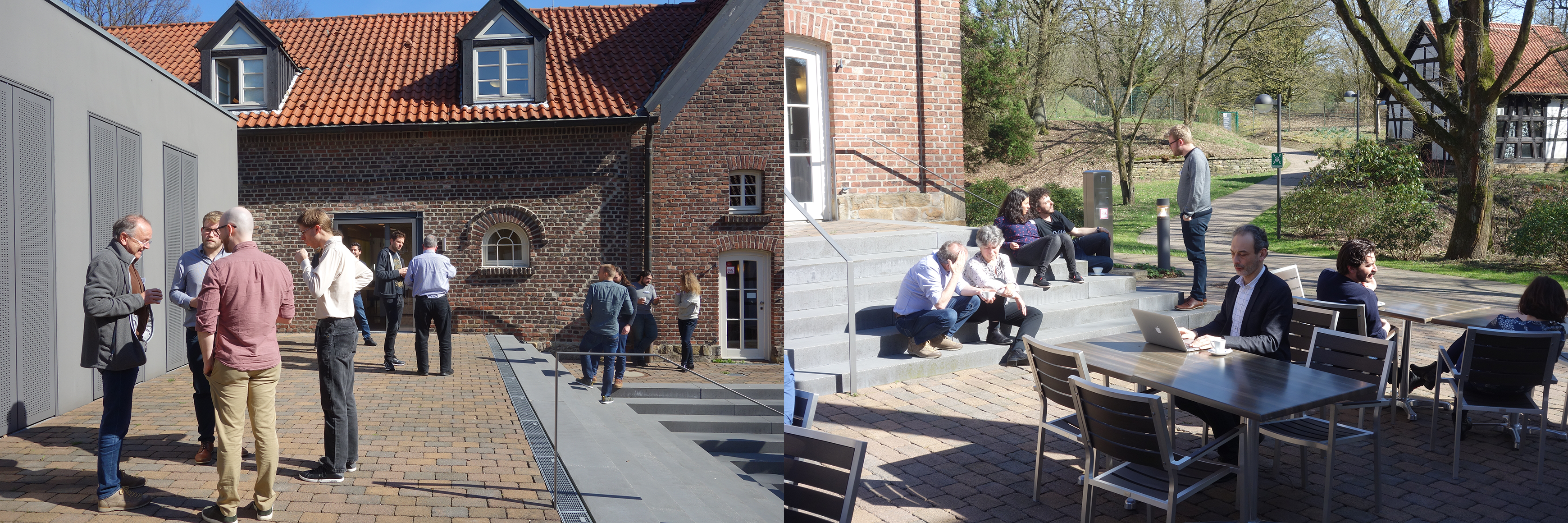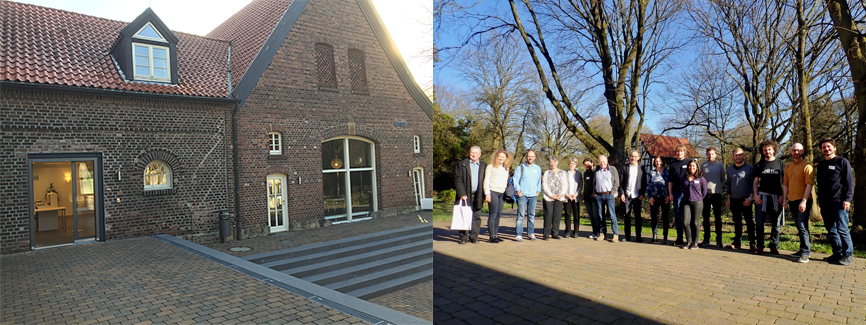‘The Extended Evolutionary Synthesis: Philosophical and Historical Dimensions’ Workshop Report
by Alejandro Fábregas-Tejeda
31 March 2019

A group of biologists, philosophers and historians of science recently gathered at Ruhr University Bochum (RUB) for the 7th Workshop on History and Philosophy of the Life Sciences organized by Jan Baedke and Christina Brandt, entitled “The Extended Evolutionary Synthesis: Philosophical and Historical Dimensions” (21-22 March, 2019). This multidisciplinary community of scholars was brought together to reflect on past and present conceptual, explanatory, methodological, and sociological challenges that developmentally-oriented views in evolutionary biology face. The Extended Evolutionary Synthesis (EES) was used as a stepping stone for many of these discussions; however, also other important philosophical and historical topics were addressed that ‘extend’ beyond this conceptual framework.
Gerd B Müller kicked off the workshop with the talk “The Extended Evolutionary Synthesis: Structure and Predictions”. He contended that the Modern Synthesis (MS) is still burdened by several explanatory deficits, especially those regarding the origins and transformations of organic form. Müller maintained that developmental systems can react to selectional or environmental perturbations in biased, emergent, and discontinuous ways, and suggested that this is something the theoretical structure of the MS is not able to cope with. Moreover, his argument goes, many explananda (i.e., things to be explained by evolutionary biologists) fall outside the purview of the standard view (e.g., the origin of novel phenotypic characters), so a different conceptual framework, namely the EES, is needed to increase the explanatory scope of evolutionary biology. For the rest of the talk, he focused on the contributions that three concepts from Evo-Devo (developmental bias, emergent patterning, and developmental bistabilities) can make to the EES, and gave empirical examples studied within the field. “Understanding the rules of developmental variation permits [researchers] to be predictive about evolutionary variation”, he proclaimed. For Müller, a strong criterion to differentiate the EES from the standard theory is the different predictions they yield. He made the argument that diverse “conceptual innovations” coming from other fields help to render the EES as a coherent explanatory framework with heuristic fruitfulness.
Next came Andrew Buskell with the talk “Arguing for the Extended Evolutionary Synthesis: Concept-Driven Explication”. Buskell proposed to distinguish different understandings of ‘conceptual change’ in arguments for the EES by employing Rudolf Carnap’s ‘explication’ model of change. Carnap understood explication as a method of re-engineering concepts for the sake of advancing theories. At first glance, Carnap’s idea seems to be fitting for the EES, as this framework is commonly said to bring conceptual change to evolutionary biology (e.g. 1). Buskell maintained that Carnap’s basic idea is that explication is a process of making concepts precise; this is usually accomplished by exerting conceptual clarifications, and then by replacing a vernacular, inexact concept (the explicandum) with a more exact concept (the explicatum). The following step would be the mutual adjustment between explicandum and explicatum, potentially leading up to formalization. According to Buskell, outcomes of this process can be multifarious: terms may diffuse back through the vernacular, be explicitly replaced, or exist alongside retained vernacular concepts. Several strategies linked to explication are often attributed to the EES by critics and advocates. Explication is, then, “one way of diagnosing proponents’ and opponents’ understanding of the role of conceptual innovation in arguing for an EES”. Different EES concepts range in novelty and perceived centrality; however, their usage within this framework seem to follow what Buskell called a ‘concept-driven approach’, i.e., that explication processes which introduces new “concepts are driven by ‘sketches’ to be filled out with further philosophical reflection and empirical results”. The opposite view is a ‘phenomenon-driven approach’ where the explication process is driven by the demands of capturing particular empirical phenomena. Buskell suggested that central concepts such as ‘reciprocal causation’ or ‘constructive development’, and a range of other concepts associated with changes in entrenched conceptions/practices of evolutionary biology (e.g., ‘evolvability’, ‘niche construction’) might be instances of a ‘concept-driven approach’. What Buskell attempted to show—using the example of niche-construction—is that such concept-driven approaches may seem to generate idiosyncratic and conflicting sets of concepts, yet the process of mutual adjustment in biology can often makes these radical-seeming concepts compatible with the concepts of standard evolutionary theory.
The third talk of the day, “The Evolution of Theory in Evolutionary Biology”, was delivered by Peter Hammerstein. He stressed the need to produce a comprehensive and comprehensible account of the EES for future generations of biologists (and this pedagogical need was later accentuated by other scholars at several points during the workshop). For Hammerstein, the EES upholds a ‘phenotype-first view’ of evolution, in contrast to the ‘genotype-fist view’ of the MS. Clashes between these two broad approaches became common in evolutionary biology during the last decades of the twentieth century. Hammerstein exemplified the divergences between genetic and phenotypic approaches to model (adaptive) evolution with his ‘streetcar theory’.2 Hammerstein defended that, in certain instances, evolutionary arguments can be based on phenotypic outcomes alone, without having to involve genetics. He then centered his talk on several elements that, for him, the EES needs to embrace fully: fighting gene centrism/reductionism (especially in modeling approaches), and tackling network evolution, plasticity, and endosymbiosis.
I, Alejandro Fábregas-Tejeda, gave the talk “Explanation and the EES: Explanatory Integration, Epistemic Goals, and Explanatory Power”. I argued that, even though the EES is said to be built around four different research areas with convergent themes,3 a view that posits the fusion of whole scientific fields is not suitable to understand the ‘explanatory integration’ being undertaken by this conceptual framework. I defended the view that there are two philosophical avenues to study explanatory integration in the EES: one linked to its epistemic goals that drive integration forward, and a second that deals with explanatory standards. Epistemic goals are complex scientific problems consisting of a set of related questions.4 An epistemic goal for the EES, among others, is to understand the constructive roles organisms play in shaping their own development and evolution, and how they change their environments in evolutionary meaningful ways. The EES, as a whole, resembles a diffuse network of multiple epistemic units derived from different biological subdisciplines and evolutionary theories/models in complex and pluralistic dialogue sharing epistemic goals (see 5). A second avenue to study explanatory integration relates to questions about what actually makes certain explanations good, and how can biologists compare the value or ‘power’ of different coexisting explanations. I presented a framework in which the value of explanations can be evaluated along various parameters, like precision, sensitivity, and cognitive salience. These parameters exhibit tradeoffs between them. I showed that there exists a usually overlooked diversity of explanatory standards within the EES (across the fields of Evo-Devo, epigenetics and niche construction theory). This diversity may lead to difficulties for theoretical and methodological integration in this conceptual framework.

Some discussions continued during coffee breaks
The first day ended with a talk by Jan Baedke and Daniel Nicholson that sparked a lot of discussion: “The Extended Evolutionary Synthesis: Old Wine in New Bottles?”. Both authors argued that this recent debate still lacks a comprehensive/suitable historical understanding of which theoretical traditions flow into the stream of the EES. Most attempts to historically contextualize the EES merely resort to contrast it with the MS and to spell out what separates this framework from the standard view. On a second plane, certain attempts point out the contributions of (some) iconic figures, such as Conrad Hal Waddington. Baedke and Nicholson maintained that such historical perspectives easily run into an impasse. With proper historiographical rigor, they showed that the theoretical tenets of the EES are not ‘post-MS’ but ‘pre-MS’, in the sense that a lot of similar ideas from early twentieth century (predating the MS) regarding the explanation of central relationships between gene-organism, organism-environment, organism-organsim are currently reappearing in evolutionary biology. These ideas were widely debated by a broad and articulated community of scholars that belonged to the ‘Organicist Movement’, including (British) organicism, dialectical materialism and German holistic biology (see 6, 7). They argued that the EES is in need of a positive narrative to account for its historical roots, besides simply claiming that this conceptual framework departs from the MS. Baedke and Nicholson concluded the talk by stressing that the investigation of these associations is of interest not only for historians: There are common conceptual and methodological challenges to be addressed by the EES that the organicists encountered in their times, but could not solve. In order to move evolutionary theory forward, the EES can definitely learn from the past by taking into account former organicist debates.
Day 2 began with Eva Jablonka’s talk “The Disciplinary Matrix of the EES”. Jablonka stated what, in her opinion, clearly demarcates the EES from the MS. The EES offers a developmental systems approach to heredity and evolution, and it is an organism-centered view. Inheritance is based on both replicative and constructive processes. Moreover, the inheritance of acquired (phenotypic) characters is a non-problematical aspect of evolution. For the EES, Jablonka argued, there is no privileged level of evolutionary analysis. She countenanced the extension of mathematical models and the development of new techniques to tease apart different inheritance inputs (e.g. CRISPR-based methods for manipulating methylation patterns, methods to analyze the methylome of ancient DNA samples), and suggested that the EES should strive to offer reformulations to concepts such as ‘homology’ or ‘cognition’. Her exposition then turned to discuss two possible models of theory change to account for the emergence of the EES: A ‘paradigm shift’ as advocated by Thomas Kuhn and Ludwik Fleck’s ideas about changes in ‘thought styles’. Jablonka did not commit to any of the views, but claimed that they offer heuristic guidance to understand the changes brought about by the EES. What new ‘exemplars’ does the EES propose for evolutionary biologists? What normative values are being introduced? Is there a ‘gestalt switch’ happening when moving to an EES stanpoint? Jablonka also compared the EES to other calls to ‘extend’ the MS during the last decades of the twentieth-century, but she recognized that there is a distinct factor unfolding: The EES does not endorse an inflammatory rhetoric and bears a renewed “emotional element of trust” for younger evolutionary biologists. She urged other EES-supporters to write a textbook for the next generations of biologists, in a Fleckian move to further consolidate the ‘thought collective’ of the EES.
Vanessa Lux spoke on “Epigenetics: Flexibilizing the Genome or Stabilizing Change?”. Lux tried to flesh out what could be some of the shortcomings of embracing molecular epigenetics (ME) to build bridges between development and evolution. She mentioned that ME adds another layer of observations related to developmental pathways, but these get contrary interpretations by developmental genetics and systems biology. This means that, at the same time, ME is depicted (i) as adding additional flexibility to the genome and the developmental processes, and (ii) as the main contributor in the stabilization of development (through epigenetic mechanisms that restrict gene expression in differentiated cells to establish lineage-specific transcriptomic profiles). Furthermore, she argued that ME plays different epistemic roles in the study of evolution as well: flexibilizing the genome (increasing mutability and physiological plasticity, and adding an additional inheritance system fostering short-term adaptations) and stabilizing change. Due to this complexity, “from an epistemological perspective, epigenetics does not provide an ideal platform to negotiate the integration of evolution and development”, she concluded.
Tobias Uller presented the talk “Evolutionary Explanations and the EES”. He began by characterizing Laland et al.3 attempt to portray the EES. Uller granted that not everything worked to establish good communication with other communities of evolutionary biologists. Paying attention to the nature of scientific explanation can help to understand why that was the case, he maintained. Following Potochnik (2017),8 Uller remarked on the important role that idealizations play in the success and epistemic aims of science (i.e. providing understanding, both a cognitive state and an epistemic achievement); it is inescapable that all scientific models implicitly or explicitly make simplifications or ignore variables/interactions. Uller attested that the three main components of evolution (heredity, variation, and selection), and their relations, have been idealized in different ways throughout history. The MS’s idealizations were directed to explain selection, and so was born the genetic representation of evolution by natural selection. The problem is that some evolutionary biologists mistake this idealization as a precise depiction of reality (i.e. they reify their models) and do not condone the production of new idealizations. The idealizations of the MS prevent developmental causes from being regarded as evolutionary causes. Uller illustrated how different idealizations work in evolutionary biology by analyzing examples of disparate understandings of ‘developmental plasticity’. In the EES, variation, heredity, and selection should not be disentangled and understood as (largely) causally autonomous, given that processes such as developmental bias, phenotypic plasticity, extra-genetic inheritance, and niche construction, offer various cases in which developmental causes can direct and facilitate evolutionary change.
The last talk of the second day was given by Philippe Huneman: “Tracing the Controversy Back to an Alternative within the Modern Synthesis: Simple vs. Complex Evolution”. Huneman provided a general overview of some of the challenges that were posed to the MS throughout the second half of the twentieth century from different disciplinary viewpoints. Huneman argued that the MS was more a sociological movement than a bona fide ‘theoretical synthesis’. He contended that, in the MS, alternation of emphases allows for integration of theoretical novelties, and that this framework also encompasses cases of acclimatization by exportation. For Huneman, it is hard to draw the lines of where the MS stops, and therefore it is hard to define an ‘extension’. He declared that many current controversies can, to a certain extent, already be found in early debates of the MS (for instance, ‘simple modeling vs. embracing complexity’ in Fisher’s and Wright’s approaches, respectively). Huneman then presented a collaboration with Eric Bapteste to provide a ‘generalised enlargement’ of evolutionary biology.9 He argued that, since the living world evolves as a dynamic network of interactions, evolutionary biology could become a science of evolving networks at different levels with the goal to explain organisational complexity. An enlargement of evolutionary biology could happen by focusing explanations and theories on collectives of interacting components and scaffolding relationships. Huneman claimed that this approach pursues the strategy of embracing the complexity of the biological world.
The workshop reached its conclusion with a general discussion session. Several questions were addressed here. For instance, the historical and sociological reasons that made the MS so powerful around the world. The need for more ethnographic and sociological studies of (changes in) community structure in evolutionary biology was highlighted. The cardinal issue became how to move the EES debate forward. How can the EES avoid mistakes that previous attempts to ‘extend’ the MS made, like biological/process structuralism? How can the EES gain acceptability and trust among evolutionary biologists? What philosophical analyses need to be conducted to understand the nature of the ongoing change? Many scholars seemed to agree on the need to write a textbook for the next generations of biologists.
Overall, the workshop addressed (i) the conceptual and explanatory foundations of the EES, (ii) some methodological and sociological/disciplinary challenges this approach needs to confront, as well as (iii) historical cases (like organism-centered perspectives in the first decades of the twentieth-century) that help understanding the deep historical roots of current debates in evolutionary biology.

Left: The workshop venue was the Beckmanns Hof, located at the outskirts of the RUB campus next to the Botanical Garden. Right: Among other attendees, the speakers of the workshop were: Peter Hammerstein (Humboldt University of Berlin, Eva Jablonka (Tel-Aviv University), Gerd B Müller (Konrad Lorenz Institute/University of Vienna), Philippe Huneman (CNRS, Paris), Vanessa Lux (Ruhr University Bochum), Jan Baedke (Ruhr University Bochum), Tobias Uller (Lund University), Alejandro Fábregas Tejeda (UNAM, Mexico City), Daniel J Nicholson (Konrad Lorenz Institute), and Andrew Buskell (University of Cambridge).
1. Uller T, Helanterä H. 2017. Br J Philos Sci axx050. 2. Hammerstein P. 1996. J Math Biol 34:511-532. 3. Laland KN et al. 2015. Proc R Soc B 282:20151019. 4. Brigandt I. 2010. Erkenntnis 73:295-311. 5. Fábregas-Tejeda A, Vergara-Silva F. 2018. Theory Biosci 137:169-184. 6. Nicholson DJ, Gawne R. 2015. Hist Philos Life Sci 37:345-381. 7. Baedke J. 2018. J Hist Biol. doi.org/10.1007/s10739-018-9549-4. 8. Potochnik A. 2017. University of Chicago Press. 9. Bapteste E, Huneman P. 2018. BMC Biol 16:56.